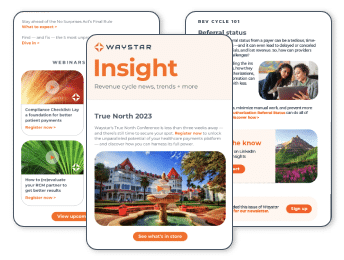After covering the ins and outs of the No Surprises Act, you may feel prepared to put the teachings into practice every day. However, what happens when the lines are blurred, and a confusing situation arises?
Keep in mind, it’s imperative to get answers by consulting with your legal team, compliance department, or trade association. However, we’re highlighting some common challenges with the No Surprises Act that may help bring some clarity.
Leverage these real-world scenarios published by the Centers for Medicare & Medicaid (CMS), so you can be ready and meet the regulations.
Exceptions to the rules
You may be surprised, but there are certain requirements and exceptions to the No Surprises Act requirements. Using this FAQ document from CMS as a guide, you can learn some of the allowances to the NSA.
This helpful resource includes information on balance billing for out-of-network emergency services, the types of providers that may never balance bill as well as disclosures of patient protections against balance billing.
Enforcement discretion for Good Faith Estimates
The Department of Health & Human Services (HHS) will exercise its enforcement discretion in situations where a Good Faith Estimate provided to an uninsured or self-pay patient fails to include expected charges from other providers and facilities that are involved in the patient’s care.
The original requirement for enforcement was set to go into effect on January 1, 2023. However, the U.S. Department of Health and Human Services (HHS) has indicated that compliance “is likely not possible” by this date. Therefore, HHS is extending the enforcement provisions timeline, pending future rulemaking.
Additionally, the HHS will also defer enforcement of the requirement that providers and facilities provide Good Faith Estimate information for individuals enrolled in a health plan or coverage until further rulemaking is issued.
IDR process fees
There are two types of fees applicable to the federal IDR process — the administrative fee for the use of the process and the certified IDR entity fee.
Each party must pay an administrative fee per single or batched IDR determination, otherwise known as a determination that involves multiple IDR items or services that are considered jointly as one payment determination.
The administrative fee for calendar year 2022 is $50. The certified IDR entity fees must be paid by each party, and the fees are due upon offer submission.
Fees for single determinations must be within the range of $200 to $500, and fees for batched determinations must be within the range of $268 to $670. The certified IDR entity, however, may receive approval from HHS to charge fees that are outside these ranges.
Applicability
Although the rules’ protections apply to individuals enrolled in a health plan either through an employer, marketplace, or an individual market health issuance insurer, the rules do not apply to individuals with coverage through programs that include Medicare, Medicaid, Indian Health Services, Veterans Affairs Health Care, or Tricare.
The rules’ protections also do not apply to individuals who are enrolled in short-term limited duration insurance, excepted benefits — including stand-alone dental or vision-only coverage — or retiree-only plans.
When identifying the types of providers that the rules apply to, the CMS states that it is assessed upon how the provider practices, rather than specialty type, license, or certification.
Although the rules broadly apply to physicians or healthcare providers acting within their scope of practice as identified under applicable state law, some requirements of the rules are only triggered by practice in a certain setting or manner.
Notice + consent requirements
Healthcare providers, facilities, and patients are not required to sign an acknowledgment that the required disclosure notice for patient protection against surprise billing was provided or received. Providers may also enter into a written agreement with the facility allowing the facility to make the disclosure instead of the provider.
Providers and facilities are also permitted to provide patients with a notice and consent form if the patient is being asked to waive their balance billing protections. However, a different notice and set of requirements will apply in these cases.
This consent form must be signed by the patient, must be retained for at least seven years, and is only applicable to non-emergency care — not post-stabilization services — provided by out-of-network providers related to a visit to an in-network facility and post-stabilization services.
Additionally, the notice and consent form may not list a provider group. Instead, the form must explicitly identify the individual provider expected to provide a given service.
Importantly, the balance billing prohibitions do not apply to situations where a patient is receiving non-emergency services from an out-of-network provider during a visit to an out-of-network facility. In such a case, the patient’s consent is not required for the provider to bill the patient directly or balance bill for the services.
Recurring items
A provider or facility may issue a single Good Faith Estimate for recurring items or services, rather than a Good Faith Estimate for each instance.
A Good Faith Estimate issued to an uninsured or self-pay individual for recurring items and services must include the expected scope of the recurring items or services in a clear and understandable manner. This includes timeframes, frequency, and total number of recurring items or services.
The scope of a Good Faith Estimate must not exceed 12 months. If additional recurrences of such recurring items or services are expected beyond 12 months, a convening provider or facility must provide an uninsured or self-pay individual with a new Good Faith Estimate.
Future visits in the same GFE as the initial visit
When providers complete the Good Faith Estimate for an initial visit, any expected charges for items or services that will be furnished in the future are not required. In addition, items or services that are not reasonably expected in conjunction with the initial visit are not required.
In these cases, new Good Faith Estimates are required for subsequent visits.
Coverage loss
If the patient converts to self-pay and informs the provider at least three business days prior to the appointment, Good Faith Estimate requirements will apply.
If the patient does not tell the practice or provider about their new uninsured or self-pay status until the day of the appointment — or anytime less than three business days before the appointment — then the Good Faith Estimate requirements do not apply.
Diagnosis codes
A Good Faith Estimate does not have to include a diagnosis code if one does not apply.
If a provider or facility is unable to provide a diagnosis code at the time of scheduling — such as for a new patient with no available history — then a Good Faith Estimate does not have to include a diagnosis code.
Whether a diagnosis code is available or not, the provider must include the expected charges and services codes for items to be furnished during the visit.
Keep in mind, when the provider is able to add a diagnosis code, they are required to do so for future Good Faith Estimates.
Unforeseen items or services
The interim final rules do not require Good Faith Estimates to include charges for items that could not have been reasonably expected.
A Good Faith Estimate provided to uninsured or self-pay individuals must include an itemized list of items or services that are reasonably expected to be furnished, grouped by each provider or facility, for that period of care.
If there is an unforeseen item or service and the difference between the billed charges and the GFE is $400 or more, the patient may dispute it, which providers will have to demonstrate why the additional charges were medically necessary and could not have been reasonably expected when the GFE was provided.
Out-of-network identification
Currently, providers are responsible for determining in- and out-of-network insurance plan usage. Providers should have unique out-of-network insurance plans for patient access use and identification.
That’s because, in the current EDI transaction, a standard and unique field for the provider’s network status does not exist. However, electronic eligibility and benefits are based on EDI payer connection — and this electronic information cannot be processed on a generic insurance plan.
Payers will display a network status benefit identification, such as 20% coinsurance and 50% coinsurance for out-of-network.
Remember, consent is required for out-of-network services for scheduled, non-emergent cases.
Independent dispute resolution
CMS launched the online Independent Dispute Resolution (IDR) Portal, which will be used by payers and non-participating healthcare providers who seek to utilize the IDR process when they are unable to agree on an out-of-network rate.
CMS previously indicated that for disputes for which the open negotiation period has expired, notices of initiation of the IDR process may be submitted within 15 business days following the opening of IDR Portal.
Because of the delay in the launch of the IDR Portal, CMS expects that a high case volume will create a backlog of IDR requests now that the IDR Portal is live.
Understand the No Surprises Act
While the No Surprises Act has many complex rules, understanding how real scenarios play out can help you better understand your role, follow the regulations, and remain in compliance.
Find this post helpful? Learn what is — and isn’t — required when it comes to the No Surprises Act.


